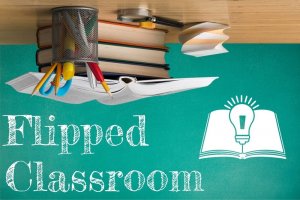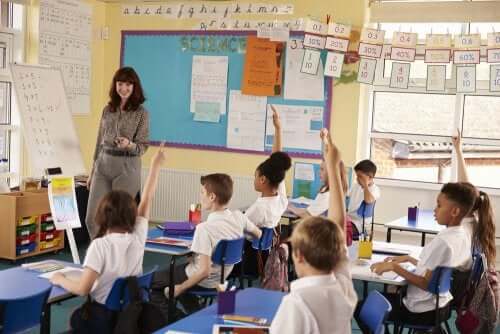Benefits of a Flipped Classroom for Teachers and Students


Written and verified by the teacher Azucena Fernández
A flipped classroom is a form of mixed, blended learning. It’s a learning model that combines virtual and in-person strategies. Teachers are increasingly harnessing the benefits of flipped classrooms.
“Flipped learning is a pedagogical approach in which direct instruction moves from the group learning space to the individual learning space, and the resulting group space is transformed into a dynamic, interactive learning environment where the educator guides students as they apply concepts and engage creatively in the subject matter.”
– Flipped Learning Network, FLN –
Traditional classrooms
Classrooms are the places where students spend most of their time preparing to become successful people in the world, a world that’s increasingly connected to new technologies. However, classrooms usually don’t evolve much in this regard.
Sometimes, interactive whiteboards replace traditional chalk blackboards. The furniture becomes more modern and perhaps more beautiful. In fact, most classrooms even have projectors. But this doesn’t mean that the classroom setting is different from what we’ve known for years; this set up usually doesn’t vary.
Normally, a teacher has a defined space in the front of the classroom. There, they make use of markers, whiteboards, projectors, and other tools to develop content. Students usually sit in their own area of the classroom, in evenly spaced rows and have to pay attention, do exercises, and be able to reproduce what they learn in tests.

This is an environment that doesn’t promote equally great academic results for all students. However, this is the classroom design we’ve seen year after year, decade after decade. Things are slowly changing, and now people are wondering what flipped classrooms look like.
What do flipped classrooms look like?
Regarding appearance, a flipped classroom looks exactly like a traditional classroom. But instead of paying attention to the teacher while in class and applying the knowledge they acquired in their homework, students see or hear lessons at home before class starts and use the classroom time to do their homework and other assignments.
Instead of telling students what to learn, how to learn, when to learn, and how to show what they learned, the teachers support them so they become capable of choosing for themselves.
The educational community has expressed concern regarding the success of flipped classrooms. For example, how to achieve change, how to make students accept them, the parents… Below, you’ll discover its benefits and how interesting it’d be to apply this educational model in reality.
The benefits of a flipped classroom for students
The traditional classroom environment is focused on the teacher, and the needs that count the most are often the teacher’s. All the tools are for the teacher to use, for them to improve their presentations and contribution to knowledge. Students tend to be passive recipients of information.
Here are some of the benefits of a flipped classroom for students:
- When students see or hear lessons at home and solve problems and apply new knowledge in the classroom, they feel less frustrated with their homework.
- This type of classroom leads to deeper and more meaningful learning.
- Students acquire an active role in the learning process. This enhances their autonomy and responsibility.
- The actual time students spend in classrooms isn’t enough for all their questions.
- This model allows students who have to miss school (due to illness, travel, or any other reason) to be updated in an easier and simpler way.
The benefits of a flipped classroom for teachers
In this increasingly digitalized era, information is available to anyone who wants to look for it. Thus, teachers are no longer the only source of knowledge for students. Nevertheless, they’re still needed. A flipped classroom is more demanding than a traditional one.
Teachers can identify each student’s learning needs and make sure that they all use the class time to develop the learning process. Here are other benefits:
- When students come to class prepared, teachers seldom need to theoretically address content. Thus, they can help students better understand concepts with practical applications.
- After class ends, students can repeat lessons as many times as necessary, until they learn the content.
- A flipped classroom gives teachers more freedom to decide how much time to spend with each student. Therefore, all students get the attention they need.
- It’s more transparent for parents. This is because they’ll know exactly what their children are doing in school.
In short, the benefits of a flipped classroom include the fact that teachers can offer students personalized and direct attention. Thus, every student’s learning process can be controlled.
A flipped classroom is a form of mixed, blended learning. It’s a learning model that combines virtual and in-person strategies. Teachers are increasingly harnessing the benefits of flipped classrooms.
“Flipped learning is a pedagogical approach in which direct instruction moves from the group learning space to the individual learning space, and the resulting group space is transformed into a dynamic, interactive learning environment where the educator guides students as they apply concepts and engage creatively in the subject matter.”
– Flipped Learning Network, FLN –
Traditional classrooms
Classrooms are the places where students spend most of their time preparing to become successful people in the world, a world that’s increasingly connected to new technologies. However, classrooms usually don’t evolve much in this regard.
Sometimes, interactive whiteboards replace traditional chalk blackboards. The furniture becomes more modern and perhaps more beautiful. In fact, most classrooms even have projectors. But this doesn’t mean that the classroom setting is different from what we’ve known for years; this set up usually doesn’t vary.
Normally, a teacher has a defined space in the front of the classroom. There, they make use of markers, whiteboards, projectors, and other tools to develop content. Students usually sit in their own area of the classroom, in evenly spaced rows and have to pay attention, do exercises, and be able to reproduce what they learn in tests.

This is an environment that doesn’t promote equally great academic results for all students. However, this is the classroom design we’ve seen year after year, decade after decade. Things are slowly changing, and now people are wondering what flipped classrooms look like.
What do flipped classrooms look like?
Regarding appearance, a flipped classroom looks exactly like a traditional classroom. But instead of paying attention to the teacher while in class and applying the knowledge they acquired in their homework, students see or hear lessons at home before class starts and use the classroom time to do their homework and other assignments.
Instead of telling students what to learn, how to learn, when to learn, and how to show what they learned, the teachers support them so they become capable of choosing for themselves.
The educational community has expressed concern regarding the success of flipped classrooms. For example, how to achieve change, how to make students accept them, the parents… Below, you’ll discover its benefits and how interesting it’d be to apply this educational model in reality.
The benefits of a flipped classroom for students
The traditional classroom environment is focused on the teacher, and the needs that count the most are often the teacher’s. All the tools are for the teacher to use, for them to improve their presentations and contribution to knowledge. Students tend to be passive recipients of information.
Here are some of the benefits of a flipped classroom for students:
- When students see or hear lessons at home and solve problems and apply new knowledge in the classroom, they feel less frustrated with their homework.
- This type of classroom leads to deeper and more meaningful learning.
- Students acquire an active role in the learning process. This enhances their autonomy and responsibility.
- The actual time students spend in classrooms isn’t enough for all their questions.
- This model allows students who have to miss school (due to illness, travel, or any other reason) to be updated in an easier and simpler way.
The benefits of a flipped classroom for teachers
In this increasingly digitalized era, information is available to anyone who wants to look for it. Thus, teachers are no longer the only source of knowledge for students. Nevertheless, they’re still needed. A flipped classroom is more demanding than a traditional one.
Teachers can identify each student’s learning needs and make sure that they all use the class time to develop the learning process. Here are other benefits:
- When students come to class prepared, teachers seldom need to theoretically address content. Thus, they can help students better understand concepts with practical applications.
- After class ends, students can repeat lessons as many times as necessary, until they learn the content.
- A flipped classroom gives teachers more freedom to decide how much time to spend with each student. Therefore, all students get the attention they need.
- It’s more transparent for parents. This is because they’ll know exactly what their children are doing in school.
In short, the benefits of a flipped classroom include the fact that teachers can offer students personalized and direct attention. Thus, every student’s learning process can be controlled.
All cited sources were thoroughly reviewed by our team to ensure their quality, reliability, currency, and validity. The bibliography of this article was considered reliable and of academic or scientific accuracy.
- Raúl Santiago, Javier Tourón y Alicia Diez. (2017). The Flipped Classroom: cómo convertir la escuela en un espacio de aprendizaje. Digital-Text.
This text is provided for informational purposes only and does not replace consultation with a professional. If in doubt, consult your specialist.








